Surfaces > Swept Surfaces > Rail Surface
Creates a surface by sweeping one or more profile curves along one or two path curves (rails).

The Rail Surface tool takes its name from its use of one or two “rail” curves. The generation curves maintain contact with the rails at the same points through the sweep, like a train traveling on a track.
The Rail Surface tool is similar to the Extrude tool, but has many more options and much more power.
After generating the rail surface, a red arrow may display, which indicates that a gap exists in the resulting geometry. RMB + click on the arrows to see the size of the gap.
Rail Surface icons
The appearance of the Rail Surface icon depends on the Generation Curves and Rail Curves settings in the Rail Surface Options window.
| Icon | | | | | |
|---|---|---|---|---|---|
| Generation Curves | 1 | 1 | 2/2+ | 2 | 2+ |
| Rail Curves | 1 | 2 | 1 | 2 | 2 |
Monorail and Birail Control options
Generation Curves
1 – Sweep one generation curve along the rail curves.
2 – Blend between a start and end generation curve along the rail curves. Use the Gen. Blend Value slider to control the midpoint of the blend.
2+ – Blend between a series of generation curves along the rail curves.
Rail Curves
The number of paths to sweep the generation curve(s) along: either 1 or 2. The default setting is 2.
Setting Rail Curves to 1 is similar to using the original Swept tool (in Alias 9.5). Setting Rail Curves to 2 is similar to using the original Birail tool.
Continuity table
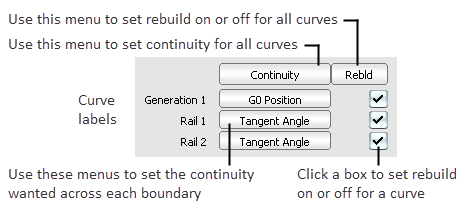
The Continuity Table displays one row for each boundary curve involved in the rail operation.
Use the pop-up menu next to each curve to set the level of continuity you want across that curve.
Use the Continuity pop-up menu above the table to set the continuity you want for all of the curves at once.
Click the checkboxes at the end of each row to rebuild the curves to reduce data and improve parameterization.
Use the Rebld pop-up menu to set rebuild on or off for all the curves at once.
For example, before creating the surface, rebuild the first rail curve, second rail curve, first generation curve, and/or last generation curve. (To rebuild interior generation curves, use the Rebuild Interior Gen. Curves option below.)
This can improve the parameterization and reduce the complexity of the new surface when the curves are complex.
Rebuilding curves can also remove multi-knots and reset the weight of all CVs in the rail curve(s) to 1. This is necessary for rail curves with multi-knots or CV weights.
Continuity
G0 Position – Only keep positional continuity. This is the default.
G1 Tangent – Try to keep tangency with a surface that shares this edge.
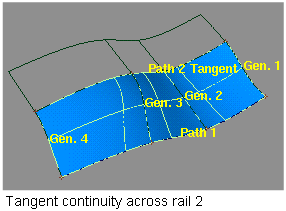
G2 Curvature – Try to keep curvature continuity with a surface that shares this edge.
Implied Tangent – Try to keep tangency with an implied surface that shares this edge. The implied surface is the surface that would be created by mirroring the new surface.
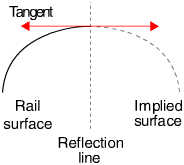
Implied Curvature – Try to keep curvature continuity with an implied surface that shares this edge. The implied surface is the surface that would be created by mirroring the new surface.
Implied Tangent and Implied Curvature are powerful features. They let you model one half of a symmetrical surface (such as a car body), and maintain continuity at the seam. When you duplicate the surface to create the other half, the seam will already be continuous.
For this to work across a symmetry plane, you must make sure the ends of the curves are tangent or curvature continuous across the symmetry plane. (For tangency, this means the tangents are perpendicular to the symmetry plane).
Tangent Angle – Try to keep tangency at an angle with a surface that shares this edge.
The Rail Surface tool calculates the tangent angle at both ends of the common edge. If the two angles are different, Rail Surface blends between them to determine the angle to keep at every point along the edge.
A tangent angle of 0.0 (or 180, -180, 360) is equivalent to G1 Tangent continuity.
Rebuild Interior Gen. Curves
Rebuilds all interior generation curves. This option is only available when Generation Curves is 2+.
This option is only available either when Rail Curves is 1 or when Rail Curves is 2 and at least one rail curve is being rebuilt.
Sweep Mode
Proportional – Rebuild the rail curves to create a surface with proportionally spaced spans and smooth parameterization based on the first rail curve.
This option is only available when Rail Curves is 2 and at least one rail curve is being rebuilt.
Spine – Use a spine curve to control the orientation of the generation curve as it sweeps along the rail.
View – As the generation curve sweeps along the rail, it only rotates in one plane (choose the plane with the Sweep Projection pop-up menu). This maintains the visual angle between the generation and rail curves.
Parallel – As the generation curve sweeps along the rail, it maintains its original orientation.
This option is only available when Rail Curves is 1. It has the same effect as the Flat option in the Extrude tool.
Natural – As the generation curve sweeps along the rail, it pivots to maintain the same angle relative to the rail curve.
This option is only available when Rail Curves is 1. It has the same effect as the Tube option in the Extrude tool..
Sweep Projection
This option controls the plane in which the generation curve is allowed to rotate when the Sweep Mode is View.
This option appears when Sweep Mode is View.
User – Type a 3D vector in the View Plane boxes to define a plane.

XY XZ YZ – Use a global plane (XY, XZ, or YZ) as the rotation plane.
Active – Take the rotation plane from the current view window.
Sweep Pivot
This option is only available when Rail Curves is 1.
Sweeping involves two pivot points:
- The point on or off the generation curve (the Generation Pivot) that stays on the rail curve as the generation curve sweeps. The generation curve rotates around and scales from this point.
- The point on the rail curve (the rail pivot) that corresponds to the generation curve before it is swept. In other words, the part of the surface corresponding to this point on the rail curve will have the exact cross section of the generation curve.
You can have Rail Surface set the pivot points automatically (as in Extrude), or set them manually for the generation and rail curves.
Off Curve – Set the pivots to a specific parameter on the rail curve and a 3D point in space for the generation curve.
- Use the Rail Pivot Parameter slider to set the parameter for the rail curve.
- Use the Gen. Space Pivot boxes to set the 3D pivot point for the generation curve.
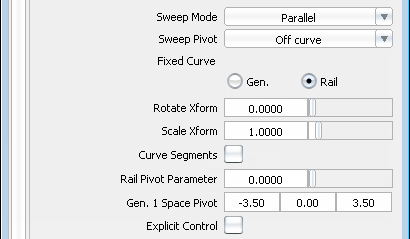
On Curve – Set the pivots to specific parameters on the two curves.
- Use the Gen. Pivot Parameter and Rail Pivot Parameter sliders to set the parameters for each curve.
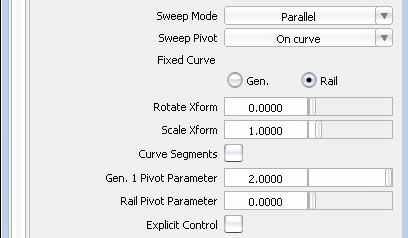
Closest – Set the pivots to the closest points on the two curves.
This option is the default. It works best when the generation curve is close to the start or end points of the rail curve.
Transform Control
This option controls how the Rail Surface tool modifies the generation curves to stay on the rail curves during the sweep. It is only available when Rail Curves is 2.
Rotate No Trim – Rotate the generation curve around the intersection with the first rail curve, so that the generation curve stays on both rails. The generation curve is not scaled.
This option only applies when Generation Curves is 1.
Rotate & Trim – Rotate the generation curve around the intersection with the first rail curve, so that the generation curve stays on both rails. Trim away any part of the new surface that goes beyond either rail curve. The generation curve is not scaled.
This option only applies when Generation Curves is 1.
Non-Prop Scale – Scale the generation curve non-proportionally, along the vector connecting the rail curves.
Scale – Scale the generation curve proportionally, to the size necessary for the curve to stay on both rails.
Blend Control
Enable the Gen. Blend Value slider to control the midpoint of the blend between the two generation curves.
This option appears when Generation Curves is 2.
Gen. Blend Value
The percentage of the distance (from 0 to 1) along the rails where the influence of both generation curves is equal.
For example, a value of 0.5 (the default) blends the two curves equally, so that the halfway point of the blend occurs at the midpoint of the rails.
A value of 0.25 places the halfway point of the blend 25% of the distance along the rail curves, hence giving more influence to the second generation curve. Conversely, a value of 0.75 would give more influence to the first generation curve.
The values 0.0 and 1.0 still blend the two curves a minimum amount.
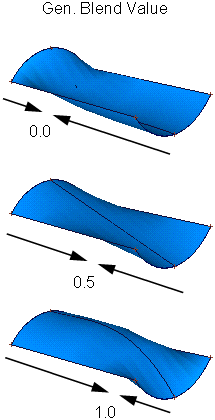
Fixed Curve
This option determines which of the curves will be moved in order to make the two pivot points coincide before the sweep. This in turn controls where the new surface will be created.
This option is only available when Rail Curves and Generation Curves are both 1.
Gen. – Keep the generation curve fixed and move the rail. The new surface is built beginning at the generation curve.
Rail – Keep the rail fixed and move the generation curve. The new surface is built along the rail curve.
Rotate Xform
Available only when Rail Curves and Generation Curves are both 1.
The degree of rotation as the generation curve sweeps along the rail curve.
For example, if Rotate Xform is 45, the generation curve will rotate 45 degrees as it sweeps along the length of the rail curve. Use negative numbers to rotate in the opposite direction.
Scale Xform
Available only when Rail Curves and Generation Curves are both 1.
The scale factor as the generation curve sweeps along the rail curve.
For example, if Scale Xform is 2, the generation curve will double in size as it sweeps along the length of the rail curve. If Scale Xform is 0.5, the generation curve will shrink by half as it sweeps.
Curve Segments
This option only applies when Generation Curves is 1.
Specify sections of the generation and rail curves to use in the sweep.
When this option is on, you will be prompted during the sweep procedure to click start and end edit points on the first rail curve and possibly (depending on the other settings) on the second rail and/or the generation curve.
After the surface is built:
Use the locators (in each corner of the surface) to change the start and end parameters of the generation and rail curves.
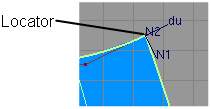
or
Use the Gen. 1 Segment and/or Gen 2. Segment text boxes to change the start and end parameters of the generation curve(s). Use the Rail 1 Segment and Rail 2 Segment text boxes to change the start and end parameters of the rail curves.

Explicit Control
Turn on this option to open the Explicit Control Options section that allows you to explicitly specify the degree and number of spans of the rail surface in both the U and V direction.
Explicit Control Options
These options are available only when Explicit Control is on.
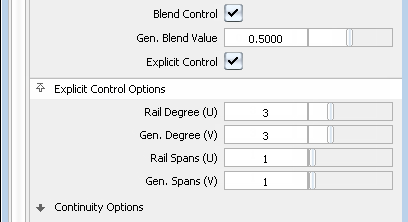
Rail Degree (U)
Degree of the rail surface in the U direction (along the rail curves).
Gen. Degree (V)
Degree of the rail surface in the V direction (along the generation curves).
Rail Spans (U)
Number of spans of the rail surface in the U direction.
Gen. Spans (V)
Number of spans of the rail surface in the V direction.
Continuity Options
Max. New Spans
Specify the maximum number of spans that can be added to the surface (in both the U and V direction) when attempting to maintain the requested levels of continuity.
If this number is too small, continuity may fail along some of the edges.
Max. New Spans is not available when Explicit Control is turned on.
Insert at Midpoint
On – Insert extra edit points at the midpoint of the span with the largest continuity deviation. This is the default, and results in a better distribution of the isoparametric curves.
Off – Insert extra edit points at the location of the largest continuity deviation.
Insert at Midpoint is not available when Explicit Control is turned on.
Colinear Options
Gen.1/Gen. 2/Rail 1/Rail 2
Check the boundaries across which you want the isoparametric curves of the new surface to line up with adjacent surfaces.
This is similar to turning off Skews in the Align tool.
Control Options
Auto Update
Update the new surface automatically as you change the values in the Rail Surface Control window.
Create History
Save the history of the new surface for later editing. If you turn Create History on, you can modify the curves that were used to create the surface, and the surface will update.
Continuity Check
Display the surface continuity locator at the boundaries between the rail surface and adjacent surfaces. The locator is persistent and will remain after you exit from the Rail Surface tool. To remove it, use Pick > Locator  to pick the locator, then select Delete > Delete Active
to pick the locator, then select Delete > Delete Active  , or toggle the checkmark off when entering Rail Surface tool again.
, or toggle the checkmark off when entering Rail Surface tool again.
Create Metadata
Specifies whether or not the Rail Surface tool creates history metadata.
The Create Metadata option is available only with Autodesk Alias 2019.2 or later.
Buttons
Reset
Restores your saved settings. If you have not saved custom options, Reset restores the installed option settings.
Update
Recalculate the surface with the current values in the Rail Surface Control window.
Undo All
Reverses any effects of the tool.
Boundary Labels
Label the generation, rail, and spine curves in the view windows. The labels also show
- the kind of continuity wanted,
- whether the continuity failed, and
- which tangents are implied.
Next
Finish the current surface and prompt for new curves.